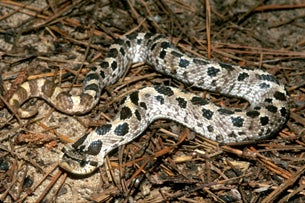SCIENTIFIC NAME:
Heterodon simus
STATUS:
Endangered/ Possibly extirpated. Known from portions of Coastal Plain and Ridge and Valley. Although at least 10 records exist, none are known since 1975. Reasons for apparent decline unknown. Southern hognose snakes are declining throughout their distribution, but still occur in parts of southern Georgia, South Carolina, and Florida, and may persist in very low numbers in Alabama. HIGHEST CONSERVATION CONCERN.
DESCRIPTION:
A short, stout bodied, nonvenomous snake. Adult lengths are typically 14 to 21 inches. The maximum recorded length is 24 inches. The most distinguishing feature is its sharply upturned and pointed snout. Adults are yellowish gray or light brown in color, often with orange-red tinges on the back. Color patterns on the body consist of a row of large squarish, dark blotches down the back alternating with smaller blotches on the sides. This color pattern is consistent throughout its range with black or melanistic specimens not known to exist. The belly and underside of the tail are light cream in color and often have a slight grayish pattern. Dorsal scales are keeled and the anal plate is divided.
DISTRIBUTION:
Occurs in the Coastal Plain from southern Mississippi to southeastern North Carolina and historically in the Ridge and Valley region of central Alabama. Sightings are infrequent and populations appear to be in decline throughout its range. In Alabama, the southern hognose snake has not been observed in over 20 years.
HABITAT:
Found in dry, upland habitats. Dry areas such as old fields, forest openings and hardwood hammocks are also utilized.
FEEDING HABITS:
Feeds mostly on toads and occasionally on frogs and lizards. Toads tend to inhale air and puff up in size when attacked by a predator, making itself harder to swallow. The snake’s loggerhead has large teeth in the back of its mouth, enabling the snake to puncture and deflate the toad, making it easier to swallow. The upturned snout is used to dig for prey, even in hard clay soils. The southern hognose is active in daylight and dim, twilight hours only.
LIFE HISTORY AND ECOLOGY:
A secretive snake that spends much of its time under surface litter or underground. Little is known of their reproductive and nesting habits. Nests in the wild have not been observed. In captivity, eggs were laid in burrows dug by the female. Clutch sizes ranged from six to 14 eggs. Breeding has been observed in the spring and hatchlings have been reported in September and October. Predators include eastern kingsnakes and eastern indigo snakes. The southern hognose snake and its more common relative, the eastern hognose snake, are often called puff adder or spreading adder. When threatened, a hognose snake will raise its head, flatten its neck and hiss loudly. If this fails to scare off the threat, the hognose snake will roll on its back, writhe as if in pain, open its mouth with its tongue hanging out and then become still, as if dead. If rolled right side up, it will immediately roll back over. The southern hognose will not bite.
REFERENCES:
Jensen, J.B. 2004, Southern Hognose Snake Heterodon simus. Pp. 42-43 in R.E. Mirarchi, M.A. Bailey, T.M. Haggerty, And T.L. Best, Eds. Alabama Wildlife. Volume 3. Imperiled Amphibians, Reptiles, Birds,And Mammals. The Alabama Press, Tuscaloosa.
Jordan, R.A. 1998. “Species Profile: Southern Hognose Snake (Heterodon Simus) On Military Installations In The Southeastern United States,” Technical Report SERDP-98-4, U.S. Army Engineer Waterways Experiment Station, Vicksburg, MS.
Mount, Robert H. 1975. The Reptiles and Amphibians of Alabama. Auburn Printing Company, Auburn. Pp.192-195.
Tuberville, T.D. 2002. Upland Snake Species Profiles: Southern Hognose Snake, Heterodon simus.
Author:
Paul Carver, Wildlife Biologist, Alabama Division of Wildlife and Freshwater Fisheries






